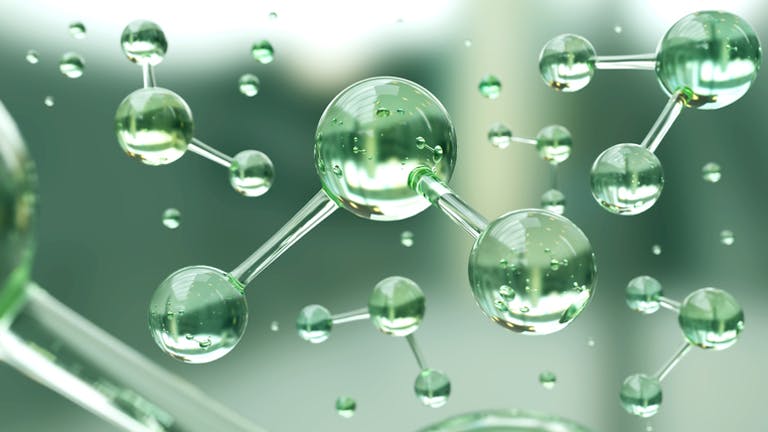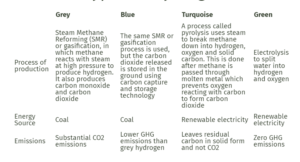Published on: September 29, 2021

CHALLENGES TO GREEN HYDROGEN PRODUCTION
CHALLENGES TO GREEN HYDROGEN PRODUCTION

WHAT : ‘Green’ hydrogen is produced by using renewable energy to split water into hydrogen and oxygen. In contrast, the conventional process of making hydrogen uses fossil fuels.
TYPES OF HYDROGEN

DEMAND
- It is expected that green hydrogen will become competitive to fossil fuel-based hydrogen by about 2030. This will happen because the cost of electrolysers is expected to go down over time and also it is hoped that their efficiency will improve.
- Demand for “green” hydrogen is going to multiply and in the case of India alone, TERI has estimated that demand for “green” hydrogen will go up from 6 million tonnes today to about 50 mt by 2050. The current world demand, incidentally, is about 70 mt.
- While our need for “green” hydrogen is imperative if we want to meet our Paris targets, the path for production and utilisation of this form of hydrogen is arduous.
CHALLENGES
- After converting electricity to hydrogen, shipping it, storing it, and then converting back to electricity, the delivered energy can be below 30 per cent of what was the initial electricity input. One would, therefore, need huge amounts of electricity from renewable sources which is going to put pressure on land.
- Transportation of hydrogen:
- While hydrogen has a very high energy content per unit of mass compared to natural gas, its energy density is low per unit of volume. This means that one would need huge containers to transport hydrogen (as compared to, let’s say, ammonia) having equivalent energy content. It’s possible to convert hydrogen to liquid form to facilitate transportation, but then it has to be cooled to minus 253 degrees Celsius and then reconverted which would require a lot of energy. Alternatively, it can be converted to hydrogen-based fuels before transportation, but this will again require additional energy.
- If we use electricity from the grid, which at least in the case of India is fossil fuel-based, then the entire purpose of producing green hydrogen, which is to lower carbon emissions, is lost. One can, of course, use pipelines for transportation, even existing pipelines where we can blend it with natural gas. There are, however, limits as to the distance hydrogen can be transported through pipelines. Today, about 85 per cent of the “green” hydrogen that is produced is done so “on-site” so that transportation problems are taken care of.
- Limitations in certain sectors:
- While the best suited is the industrial sector (mainly steel, ammonia and refineries), its use in transport and power is somewhat restricted since it has to compete with batteries. Hydrogen, however, can be used in heavy duty, long-distance transportation because batteries have low energy-to-weight ratios and they take a long time to charge compared to fuel cells.
- For smaller distances, battery-charged vehicles are the most viable option economically. The best use of hydrogen in the power sector is for storage. Hydrogen-based storage is ideal for inter-seasonal storage, that is, storage over several weeks/months to take care of the lean months of renewable generation.
- Not all countries will find it economically viable to produce “green” hydrogen at home. The International Energy Agency has in its 2021 report cited the example of Japan which would be better off importing “green” hydrogen from Australia. Production is most suited for those countries which have high gas prices and low cost of renewable generation. Going by this, India is ideally placed for making “green” hydrogen domestically. For the Persian Gulf countries, which have low gas prices, it would be prudent to go in for gas-based “green” hydrogen and then apply CCUS to reduce the carbon footprints. So each country will have to chart out its own course depending on its ground realities.
INDIA & GREEN HYDROGEN
- India has the advantage of producing cheap electricity from renewable sources and thus, we have the potential of becoming hydrogen exporters and should not lose this opportunity as we have lost in the case of solar cells and batteries.
- We need to draw up a road map for “green” hydrogen and also bear in mind that we have to make huge investments in research and development to lower the cost of electrolysers and make India a manufacturing hub. Additionally, we need to incentivise the private sector to move towards “green” hydrogen. A lot of work will also be required to lay down standards for large-scale use of hydrogen besides framing safety regulations.
- The recently announced Hydrogen Mission will swing into action immediately and finalise the next course of action after consulting all stakeholders

